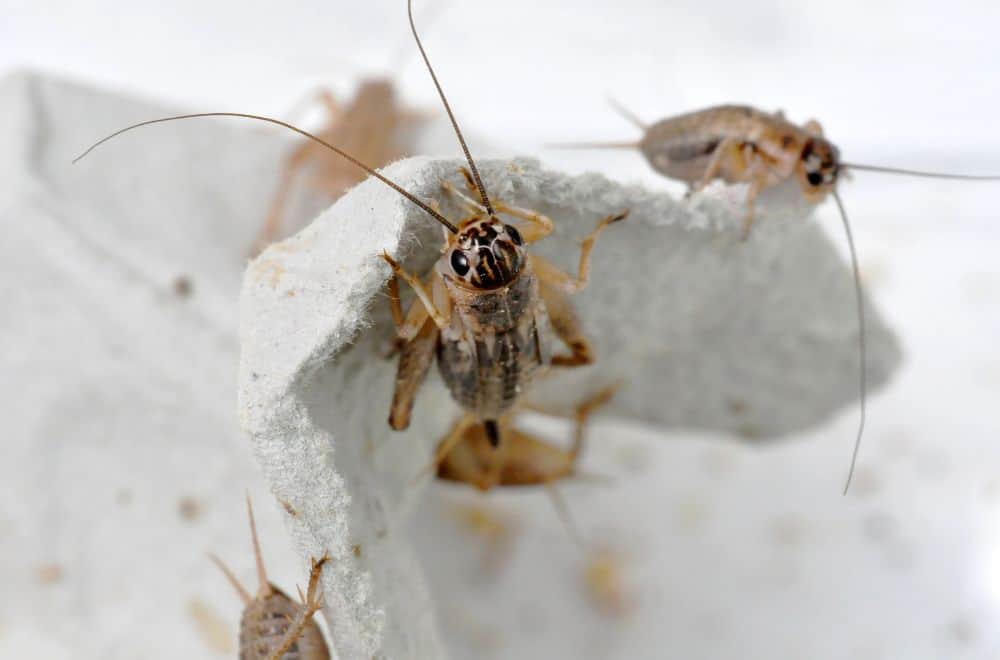Depending on how you view them, house crickets are fascinating creatures, potential food for other pets or simply pests that need to be exterminated – but in any of these cases, knowing about the food they prefer to eat is vital knowledge.
Understanding what they feed on will help you kill them, keep them alive or allow you to provide a nutritious meal for your other pets – and to give you all the information you need, in this post, we answer the question, what do house crickets eat?
House crickets – an introduction
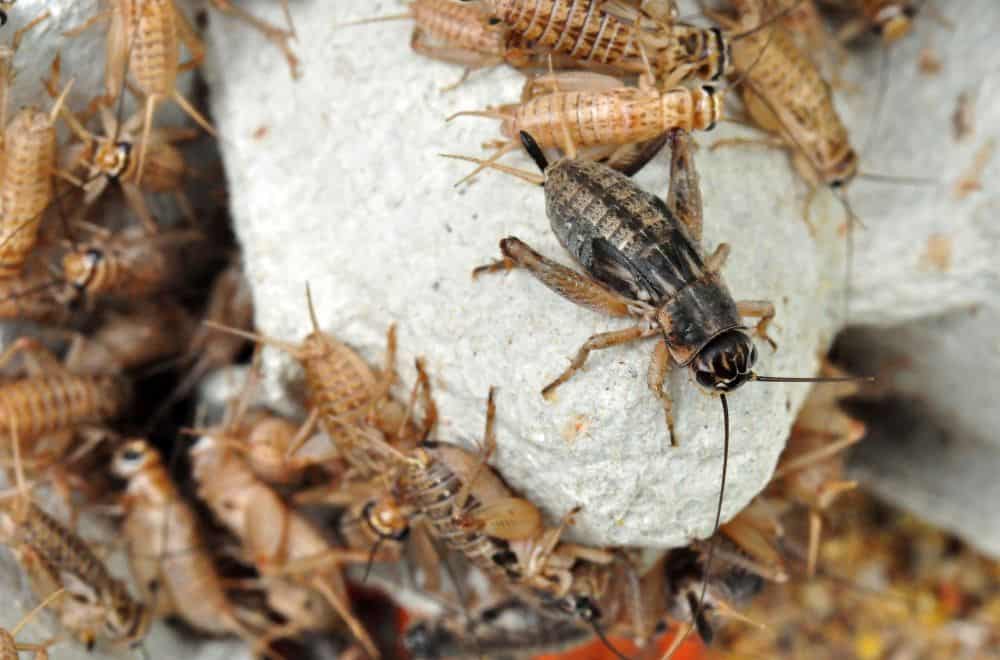
Known scientifically as Acheta domesticus, house crickets are insects that are best known for the loud chirping sound they produce by rubbing their wings together (known as “stridulation”).
House crickets are often found in and around human habitations, which explains both their scientific and common names. They are considered an introduced species in the US, and they most likely originated in West Asia.
You can identify them as insects with six legs, long antennae and wings that fold flat on their backs. Adults grow to about 3/4-7/8” in length and are yellowish-brown in color. House cricket nymphs look like adults but have no wings.
To many people, these insects are simply a pest to be exterminated. Outdoors, they can eat through plants from your garden, and they can also infest your home, much like cockroaches.
However, other people keep them in captivity. They are easy to keep as pets in their own right, but they are more commonly kept as food for other animals such as snakes or lizards – since the 1950s, they have become established as the standard feeder insect in the pet industry.
Why do we need to know what they eat?
As a result of their different roles as pests, pets or pet food, people asking about house crickets’ diet may have different motivations for wanting to know what they eat.
Someone keeping one in captivity will want to know how to keep them healthy while anyone dealing with an infestation will just be interested in how to kill them.
For this reason, we’ll now take a detailed look at what house crickets eat in the wild, in our homes as uninvited visitors and when kept in cages as pets or as pet food.
What do house crickets eat in the wild?
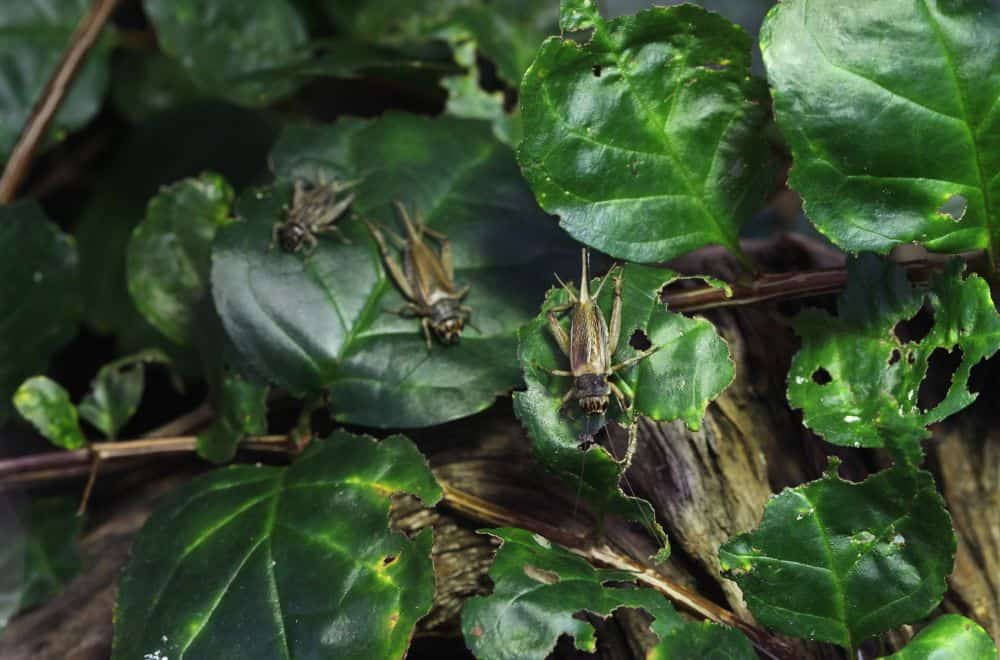
There are many different species of cricket, and they each prefer a slightly different diet – some are completely herbivorous while others are much more predatory.
However, house crickets are unfussy omnivores and will happily eat most things that come their way, including both plant and animal matter.
In the wild, this may include a mixture of flowers, seeds, fruit, growing leaves, seedlings, grasses, organic remains, decaying leaves, fungi, invertebrate eggs, larvae, pupae, aphids, other insects and even the bodies of dead crickets.
What do crickets eat in our homes?
Since they are omnivorous, house crickets will eat a wide range of foods that they find in our homes.
This may include grains, leftover fruit and vegetables, crumbs, other trash, pet food, house plants and insects. They will even eat the bodies of other crickets if they find them.
Furthermore, they will also eat other things we wouldn’t normally consider food such as fabrics – especially natural fabrics like wool or silk – and wallpaper glue.
They have strong jaws and can easily chew through cardboard or thin plastic packaging to get to any food inside.
What do crickets eat in captivity?

If you want to keep house crickets in captivity, you should try to feed them a diet that is as close to what they would eat in the wild as possible.
Here are some of the things you can feed them:
1. Vegetables
One good thing about keeping house crickets is that you can feed them a lot of the parts of vegetables that we normally cut off and throw out.
You can feed them the tops of carrots and the outer leaves of cabbages, the latter being a rich source of vitamins K and C.
Crickets also like lettuce, which is rich in vitamin A and potassium, so you can break off leaves for them or just feed them the leftovers from a salad.
Potatoes are a good option too and are rich in the starch that crickets need to thrive – you can just feed them the peel, making use of the part you would normally discard.
2. Fruit
Crickets enjoy eating fruit such as apples, bananas and oranges. With apples, you can feed them the cores, again, using the part you wouldn’t normally eat as cricket food. This will provide them with plenty of fiber and potassium.
Bananas, chopped up into small pieces are also good for crickets, and like apples, they are a rich source of fiber and potassium.
Oranges will provide them with all the vitamin C they need.
3. Grains
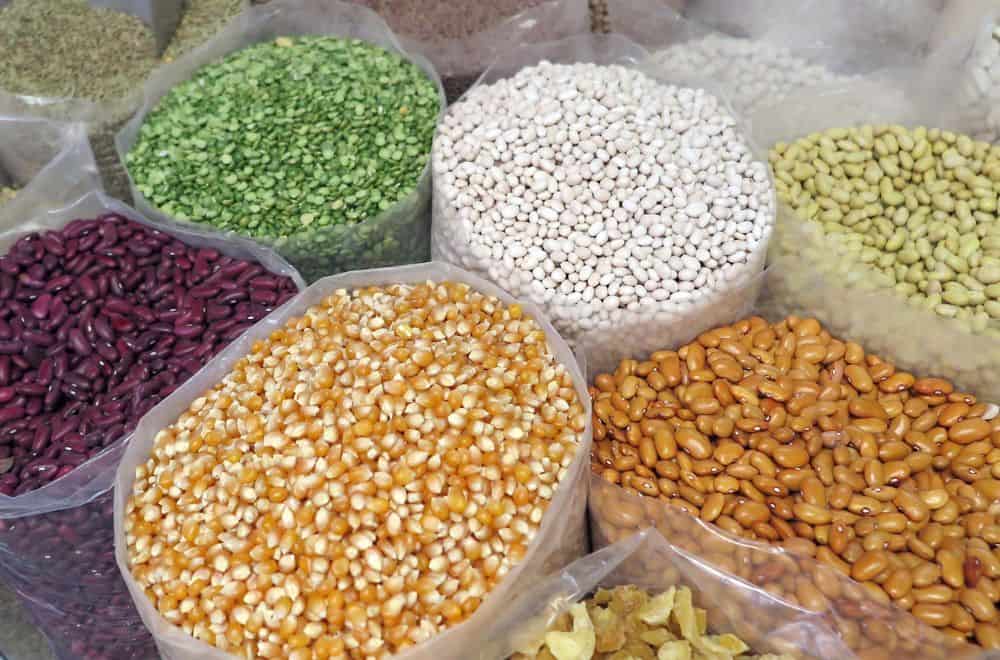
Crickets will also benefit from having access to grains, so you can provide them with things like rice cereal, wheat germs and alfalfa from time to time too.
4. Pet food
Fruit, veg and grains alone aren’t enough for a cricket to thrive, so you will also need to give them pet food as a supplement. For example, dried cat or dog food is a good option – but you should break it up into small pieces with a hammer to make it easier for them to eat it.
5. Supplements
If you are feeding your crickets dried dog or cat food, you won’t need to give them supplements, but if they aren’t receiving the vital nutrients these extra food items provide, you will need to think about how to fill the gaps.
To do this, you can use fish flakes or reptile flakes. Alternatively, it’s also possible to buy commercial pet food specially designed for crickets, although, depending on where you live and how good the pet stores near you are, you may need to order this online.
6. Water
You should also provide water for your crickets to drink.
How to feed and water a cricket
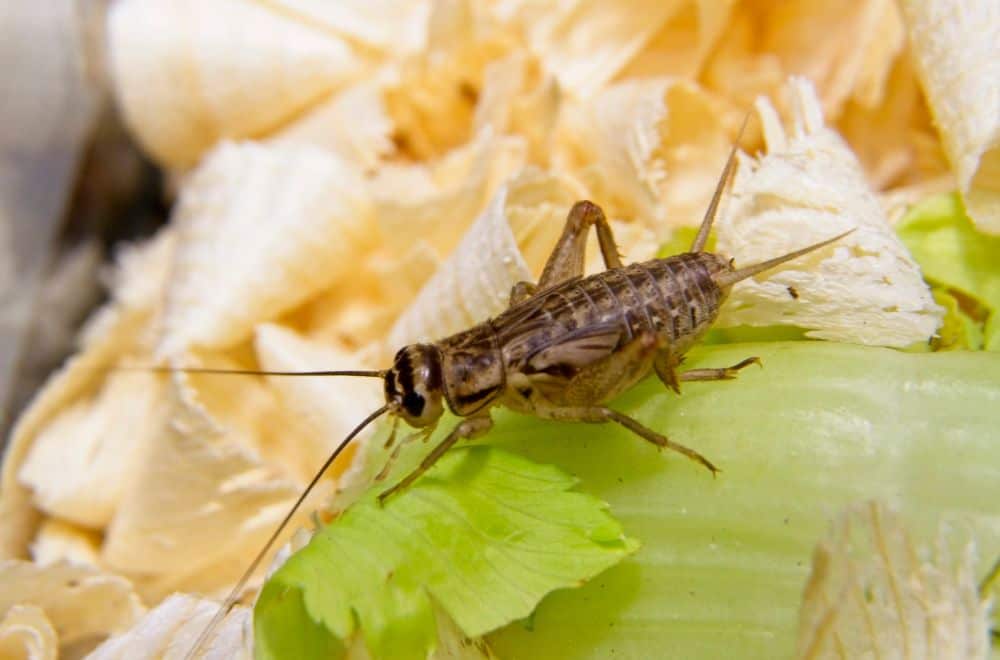
Now we know what to feed crickets, let’s also look at a few feeding pointers for making sure your crickets remain healthy.
1. Don’t allow food to go moldy
For food like fresh fruit and veg, make sure you don’t let it go moldy as this can make your crickets ill. Place the food in the cage and let them eat what they can – and then remove it before it starts to go bad.
With dried food, on the other hand, since it won’t go moldy (or at least not anywhere near as quickly), it’s safe to leave it in the cage for longer periods until they eat it all.
2. Keep food and water at one end of the cage
If you place all the food and water at one end of the cage, they can go there when they’re hungry – and it will avoid having the food spread throughout the cage, keeping everything cleaner and more hygienic.
Fruit can be placed directly into the cage, but dried pet food should be placed in a dish.
These practices will keep the crickets healthy and free of disease.
3. Make sure they don’t drown
Crickets can easily drown if they fall into deep (or even not-so-deep) water, so you need to take measures to prevent this from happening.
One popular technique is to place stones or pebbles of the kind used in fish aquariums into a dish and then fill it with water. This will provide them with all the water they need, but they won’t be able to fall in and drown.
4. Replace the water regularly
You should remove any water that’s left over regularly and tip it away, giving them fresh water to drink instead. This will prevent the water from going stagnant or becoming unhygienic, which will help keep your crickets disease-free.
5. Check the food every two days
Check the food in the cage at least once every two days and replenish it as necessary. If you leave your crickets without food for too long, they will quickly starve – and if they are starving, they may even turn on each other in an attempt to survive.
How do you know if you have a cricket infestation in your home?
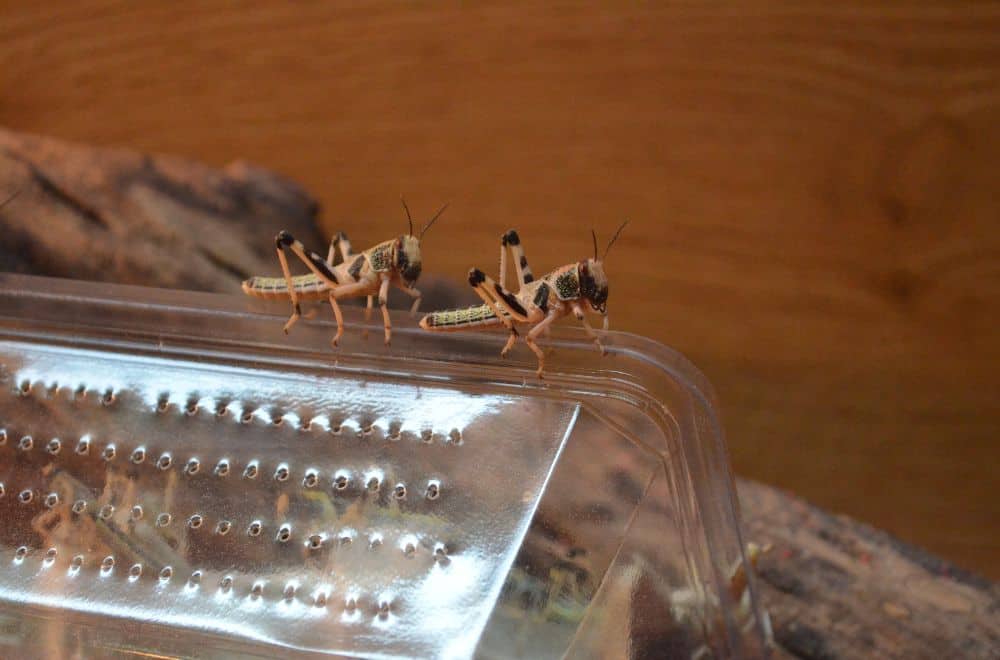
Cricket infestations are usually easy to spot, and the first thing you’ll notice is the crickets themselves.
You’re likely to see them in places like around the trash, in the basement, in the bathroom or in the kitchen since these are the places where they can find the food and water they need.
Another tell-tale sign that you have crickets in your home is the chirping. This can be loud and will usually happen at night when they are most active.
If you just hear it once and then it goes away, it could just mean that a cricket accidentally strayed into your home but has already left.
However, if you hear the noise night after night and from more than one insect, it’s an unmistakable warning that crickets have moved into your home.
Something slightly less obvious you might notice is that crickets have been chewing on your fabrics.
You will see damaged fabric that looks like it has started to unravel where the crickets have pulled out the threads – and if you take a magnifying glass, you may also notice the tiny marks from their mandibles where they have been biting the fabrics.
How can you get rid of crickets from your home?
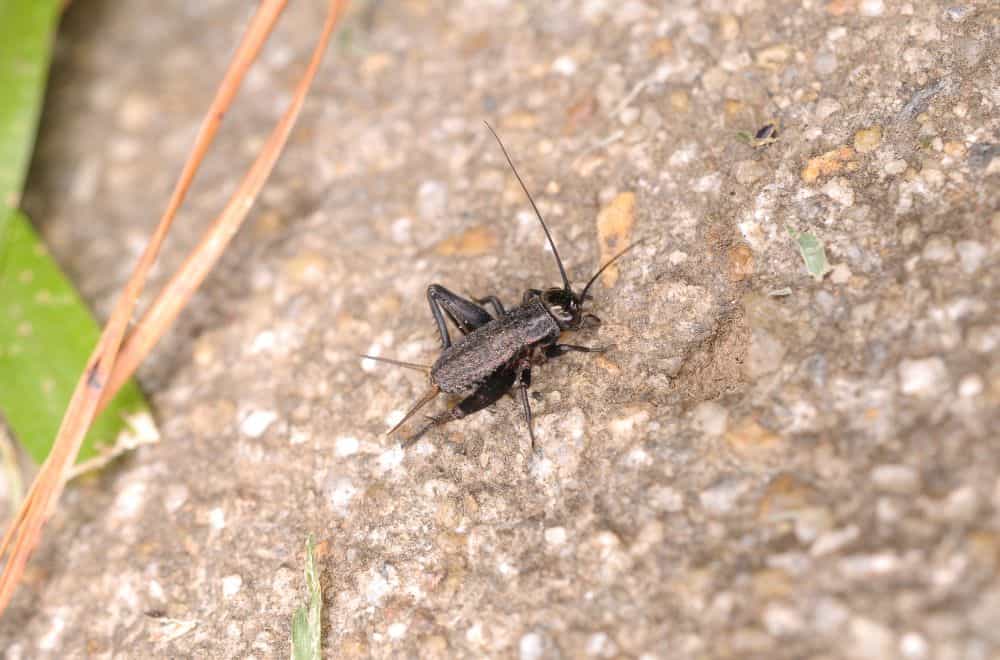
If you have crickets in your home, there are a few things you can do to try to get rid of them.
First, increase ventilation throughout your home and reduce moisture. Crickets prefer slightly damp environments, so if it’s too dry, they will move on.
You should make sure that no food is available to them, so clear up any crumbs or drink spills immediately. Ensure your trash cans are sealed so they can’t get food from there either.
Also, store all your food in airtight plastic or glass containers to prevent them from eating through the packaging to get to it.
Finally, vacuum your house thoroughly to suck up any eggs that have been laid – as well as any adults you come across.
FAQs
-
Does it matter what you feed them if they are food for other pets?
If you are keeping crickets to feed to other pets such as reptiles, you should feed them a nutrient-rich diet.
This is because the nutrients they consume will be passed on to your other animals, and if the crickets are living on a nutrient-poor diet, the animals that eat them will be receiving a nutrient-poor diet too.
-
What’s the difference between a cricket and a grasshopper?
It’s easy to confuse crickets and grasshoppers, but they’re not the same. One of the easiest ways to tell them apart is to look at their antennae since crickets have long antennae while grasshoppers’ antennae are short.
The way they stridulate (chirp) is different too. Crickets do it by rubbing their wings together while grasshoppers do it by rubbing their legs on their wings – but this is unlikely to help you distinguish one from the other when you see them!
-
Can crickets overfeed themselves?
No, unlike some pet animals such as goldfish, crickets are capable of self-regulating. This means for the dried foods you give them, you can leave plenty of food in their cage and they will just take what they need.
-
What is the best temperature for keeping crickets?
Although the answer to this question varies according to the species, most species you will find in the US – including the house cricket – prefer temperatures of around 70-75°F.
Easy pets but unwelcome guests
As we have seen, house crickets’ unfussy eating habits make them easy to keep as pets or as pet food animals, but for the same reasons, they can be unwelcome guests since they will eat just about anything they can find.
If you want to get rid of them, you’ll need to work at removing all sources of food and water to persuade them to move on. However, to keep them alive and healthy, you should try to feed them a varied, nutrient-rich diet that most closely matches what they eat in the wild.
